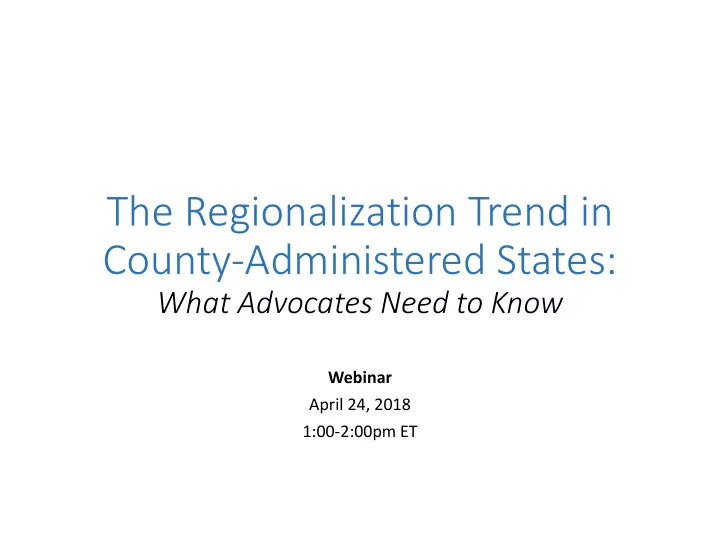

The Regionalization Trend in County-Administered States: What Advocates Need to Know Webinar April 24, 2018 1:00-2:00pm ET
Webinar logistics • Yes! The webinar will be recorded and circulated to registrants in the near future. • Ask questions! Type them in the question pane on your control panel.
Today’s Agenda Introduction / Project Background Regionalization Primer Wisconsin: Fully Implemented North Carolina: Under Consideration Ohio: Voluntary Approach Advocacy Considerations Q & A
Today’s Speakers • Maureen Fitzgerald, Hunger Task • Jennifer Tracy, Consultant in Force (Wisconsin), California, jenn@jenntracy.com Maureen@hungertaskforce.org • Rachel Cahill, Consultant in Ohio, • Brian Kennedy, North Carolina rachel@rcahillconsulting.com Justice Center, briank@ncjustice.org
Project Background December February 2018: Mid-2017: September April 2018: Final Early 2016: Ad 2017: Webinar to California 2017: Two report hoc group of Preliminary share findings Association of consultants - published; advocates findings shared more broadly; Food Banks Rachel Cahill Webinar on begins with small Build network requests and Jennifer regionalization; discussing group of of advocates funding for Tracy - are hired Cheat sheet for common advocates for from county- comparative to execute data requests challenges feedback and administered research effort project (coming soon) prioritization states
What is a County-Administered State? • 10 states are considered “state- supervised, county-administered” • ~30% of SNAP recipients nationwide live in a county-administered state • Single unifying definition: SNAP enrollment process conducted by county employees in county-run offices • Wide range of flexibility provided to counties on business processes (i.e. how to organize workflow)
BIG PICTURE: How well do County-Administered States perform compared to other states? SNAP Participation Rate - FY 2015 100% 96% 95% 90% 87% 87% National Average 85% 83% 83% 80% 76% 75% 74% 75% 70% 70% 65% 62% 60% 55% 50% CA CO MN NC ND NJ NY OH VA WI
BIG PICTURE: How well do County-Administered States perform compared to other states? CAPER Rate - FY 2015 70% 60% 55% 50% 47% 40% 40% 37% 36% 29% 30% 27% National 24% Average 22% 21% 20% 10% 0% CA CO MN NC ND NJ NY OH VA WI
Why Regionalization?
What are the biggest barriers to SNAP access in your state? n=15 Ineffective document management 13 12 Limited and/or poorly trained county case workers 12 Poor State oversight and inconsistent county performance 11 Problems reaching a worker/getting case info Problems with Notices sent to clients 11 10 Federal policies that limit State flexibility to serve the vulnerable 9 Language Barriers (translation/interpretation) 7 State polices that restrict eligibility Other 5
Where is “Regionalization” under Consideration?
Regionalization Models • Fully implemented • Established by state legislation in 2011. WI • Under consideration • 2017 law requiring “regional supervision” with plan due in November 2018. NC Must be operational by March 2020. • Partially implemented • Voluntary model, started in 2014. To date, ~40 (of 88) counties participating OH with 78 counties “committed” to the model. • Under consideration • 2017 law created two-year pilot w/ state assuming county costs and paving ND way for county/state redistribution of responsibilities.
Wisconsin • 10 county consortia + (state-run) Milwaukee • Result of state legislation in 2011
Wisconsin Portion of Monthly Dashboard, February 2018
Wisconsin Portion of Monthly Dashboard, February 2018
North Carolina
North Carolina • State legislation in 2017 (HB 630): “AN ACT TO ESTABLISH SOCIAL SERVICES REGIONAL SUPERVISION AND COLLABORATION…CREATE REGIONAL SOCIAL SERVICE DEPARTMENTS…” “…Whereas, county social services agencies are facing significant resource and administration challenges in areas other than child welfare, such as public assistance and adult services…” “…Whereas, it has been challenging for the State to effectively supervise administration of complex social services programs in 100 counties and it would be more efficient and effective for the State to supervise fewer local agencies…”
Ohio • Voluntary model (i.e. counties opt-in) called “County Shared Services” • New technology facilitates case-sharing • Vision for standardization (e.g. hours of operation, approaches to verification) not fully realized • A few counties have opted for full consolidation
Ohio’s County Shared Services (CSS) Map
Some questions for stakeholders to raise as their states consider Regionalization: What are the core goal(s) of regional consolidation in our state? What are the risks of consolidation on client access? How can the state ensure that SNAP applicants and recipients will be better off in the new system? Which functions of SNAP administration are well-suited for consolidation and which ones should remain at the local level? What reporting metrics will be developed to ensure proper oversight and transparency of regional leadership? Access metrics should still be reported at the local office/county level. What best practices and lessons learned can be gleaned from first adopters, like Wisconsin?
Questions?
Project Contacts Rachel Cahill, Consultant Rachel@rcahillconsulting.com Andrew Cheyne, Director of Government Affairs California Association of Food Banks Andrew@cafoodbanks.org Jennifer Tracy, Consultant jenn@jenntracy.com
Thank you!
Recommend
More recommend